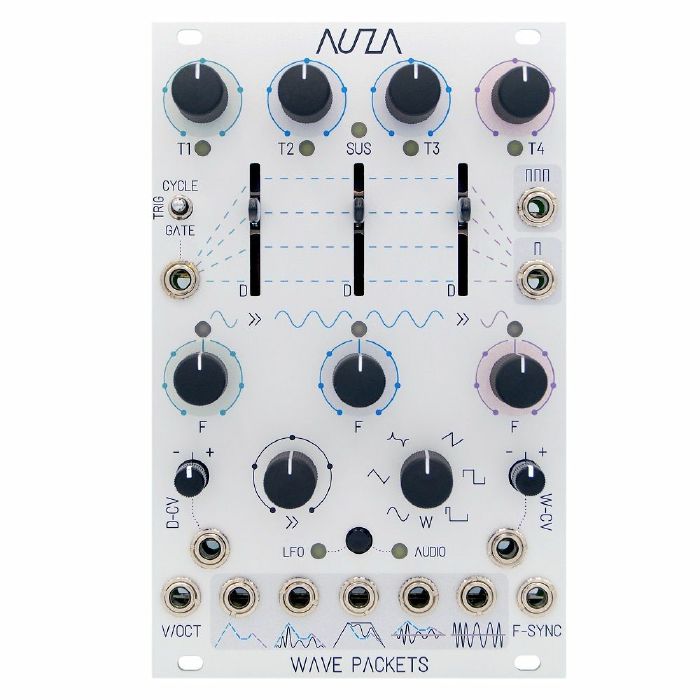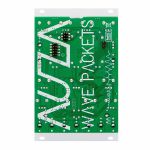Auza Audio Wave Packets Wave Source Module
Click for better price or call
+44 20 7424 1960
(quote 882170)By Auza Audio



Delivery
Features
Manual/brochure
Returns & refunds
Finance
- Ability to design novel control voltage shapes, or use as an audio source
- 5 simultaneously utilisable outputs with distinct models - 3 unipolar, 2 bipolar
- 24-bit wavetable audio oscillator, voltage-precise LFO
- Continuous wave shape morphing, including PWM and skewable exponential in to sawtooth
- Contour function drawn from 3 slider controls
- Traverses through 3 frequencies with glide control
- Colour-frequency representation LEDs
- 4 time stages, with LED indication, each adjustable between 0s (skip) to 10s, and optional sustain stage
- ''Linked'' stage time mode which allows the ability to sync stage times to the oscillator period
- Ability to stretch and shrink the overall wave packet using V/OCT in linked mode
- Various excitation/ trigger options, including gated, trigger, cycle, pingable-stages cycle, and free-running modes
- Ping input frequency/ rate control, with multiplication/ division or offset controls
- EOS, EOC outputs
- Accurate 16-bit tracking V/OCT input, +-9V range. -V useful for general FM
- Depth and wave shape CV inputs, running at oversampled audio rates
- Skiff-friendly 25mm, 16HP module
If you decide a product is not suitable within 14 days of delivery, you can return it to us for a replacement or refund. Returns must be unused and in their original, undamaged packaging.
Some items are excluded from our money back guarantee:
- Computer software that has been unsealed or registered
- Any item that comes directly into contact with the nose, ears or mouth
To arrange a return, just contact our customer service department on 020 7424 2800 or via our customer support form.
Auza Audio Wave Packets Wave Source Module
Auza's debut release is a winner, capable of generating envelopes, modulation sources or complex oscillator signals. Huge depth, hands-on tweakability and excellent CV control.
Supplier's Notes:
Enveloped actions. Dynamic oscillations.
Bursts of energy. Capsulated audio.
Wave Packets is the first Eurorack module from design team Auza. Capable of generating complex envelopes, modulation signals and audio, the module allows you to sculpt your sound by producing time-limited signals or "wave packets". Each wave packet is determined in the four primary dimensions of time, depth, frequency and wave shape. With five distinct unipolar and bipolar outputs, an infinite and unique range of shapes and sounds can be produced: an envelope growing from nothing to wild oscillation, a punchy bass drum with monstrous pitch decay, a ping-multiplied burst generator, an amplitude-varying LFO or timbre-morphing oscillator. This novel model combines frequency-dynamic oscillation and function generation for crafting modulation and audio signals that fuel creativity. What emerges is a highly versatile production tool kit in 16HP.
The module can operate in three excitation modes: trigger, gate, and cycle. Once animated, the 3 depth sliders sculpt the wave packet's overall contours, whilst the wave shape, glide and 3 frequency controls determine its oscillations through time. The five outputs map five distinct interactions between the contour function and oscillations. These can be summarised as: the pure contour, the unipolar wave, the resonating contour, the capsulated oscillator and the pure oscillator. As the outputs are simultaneously utilisable the module is fully self-patchable, allowing for new wave packet models to be achieved. Examples include patching a unipolar output into wave shape CV for morphing across timbres, or patching a bipolar output into depth CV to achieve audio-rate modulation. By utilising multiple outputs at the same time, Wave Packets can act as a hub for orchestrating movement across new and exciting patches.
Model overview
Wave Packets is all about creating time-limited or time-repeating signals in one form or another. The timing diagram below provides a visual overview of how the module functions. In a similar way to how the controls are laid out on the module panel, time is depicted as moving from left to right - traversing through the individual time stages. Each stage is delineated by the white vertical lines within the diagram. All of Wave Packet's input parameters (potentiometer controls, modes and external inputs) are noted in red, and the parameters which are dynamic in time are placed directly on to the graph.
The contour function and frequency-dynamic oscillator provide the main ingredients of how the five outputs are formed - each output deploying a different recipe. The contour function creates linear segments from each T stage to the next, with the 'minimal contour' line (coloured, dashed line) determined by the shape drawn by the three D (depth) sliders, and the 'maximal contour' line (white, dashed line) - a fixed shape resembling an ASR envelope. The oscillator, at either LFO or audio rate, provides oscillations which transition through three target F frequencies, with the >> (glide) control determining the transition length from each frequency to the next at the T1-T2 and T3-T4 stage boundaries. For three of the main outputs, one or both of the contours are used for moulding the oscillation in to an overall form, and the remaining two outputs provide direct feeds from either the oscillator or the contour function.
Supplier's Notes:
Enveloped actions. Dynamic oscillations.
Bursts of energy. Capsulated audio.
Wave Packets is the first Eurorack module from design team Auza. Capable of generating complex envelopes, modulation signals and audio, the module allows you to sculpt your sound by producing time-limited signals or "wave packets". Each wave packet is determined in the four primary dimensions of time, depth, frequency and wave shape. With five distinct unipolar and bipolar outputs, an infinite and unique range of shapes and sounds can be produced: an envelope growing from nothing to wild oscillation, a punchy bass drum with monstrous pitch decay, a ping-multiplied burst generator, an amplitude-varying LFO or timbre-morphing oscillator. This novel model combines frequency-dynamic oscillation and function generation for crafting modulation and audio signals that fuel creativity. What emerges is a highly versatile production tool kit in 16HP.
The module can operate in three excitation modes: trigger, gate, and cycle. Once animated, the 3 depth sliders sculpt the wave packet's overall contours, whilst the wave shape, glide and 3 frequency controls determine its oscillations through time. The five outputs map five distinct interactions between the contour function and oscillations. These can be summarised as: the pure contour, the unipolar wave, the resonating contour, the capsulated oscillator and the pure oscillator. As the outputs are simultaneously utilisable the module is fully self-patchable, allowing for new wave packet models to be achieved. Examples include patching a unipolar output into wave shape CV for morphing across timbres, or patching a bipolar output into depth CV to achieve audio-rate modulation. By utilising multiple outputs at the same time, Wave Packets can act as a hub for orchestrating movement across new and exciting patches.
Model overview
Wave Packets is all about creating time-limited or time-repeating signals in one form or another. The timing diagram below provides a visual overview of how the module functions. In a similar way to how the controls are laid out on the module panel, time is depicted as moving from left to right - traversing through the individual time stages. Each stage is delineated by the white vertical lines within the diagram. All of Wave Packet's input parameters (potentiometer controls, modes and external inputs) are noted in red, and the parameters which are dynamic in time are placed directly on to the graph.
The contour function and frequency-dynamic oscillator provide the main ingredients of how the five outputs are formed - each output deploying a different recipe. The contour function creates linear segments from each T stage to the next, with the 'minimal contour' line (coloured, dashed line) determined by the shape drawn by the three D (depth) sliders, and the 'maximal contour' line (white, dashed line) - a fixed shape resembling an ASR envelope. The oscillator, at either LFO or audio rate, provides oscillations which transition through three target F frequencies, with the >> (glide) control determining the transition length from each frequency to the next at the T1-T2 and T3-T4 stage boundaries. For three of the main outputs, one or both of the contours are used for moulding the oscillation in to an overall form, and the remaining two outputs provide direct feeds from either the oscillator or the contour function.
Read moreRead less
Auza Audio Wave Packets Wave Source Module
Click for better price or call
+44 20 7424 1960
(quote 882170)By Auza Audio
$413.58
Add to Wishlist

 USD
USD







